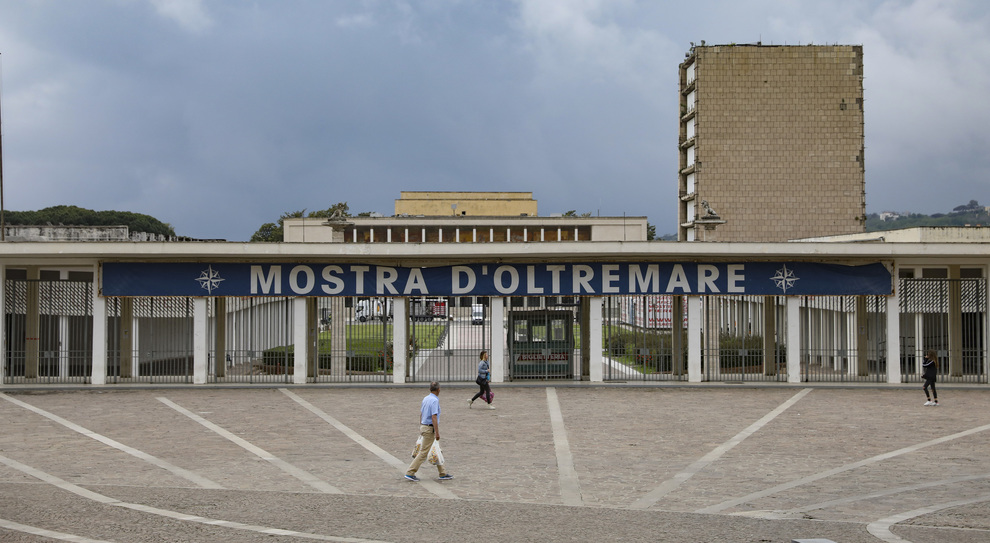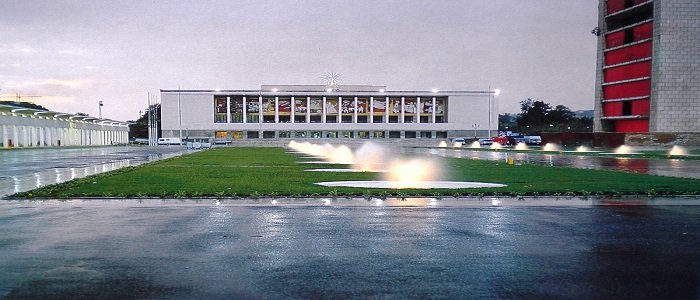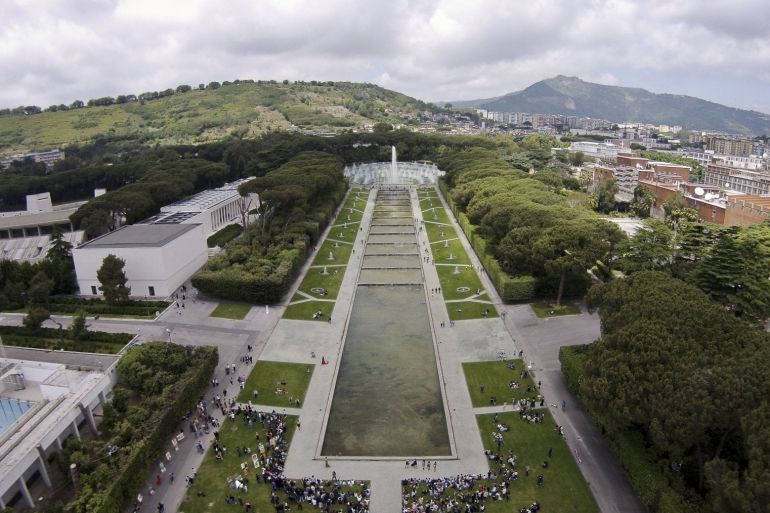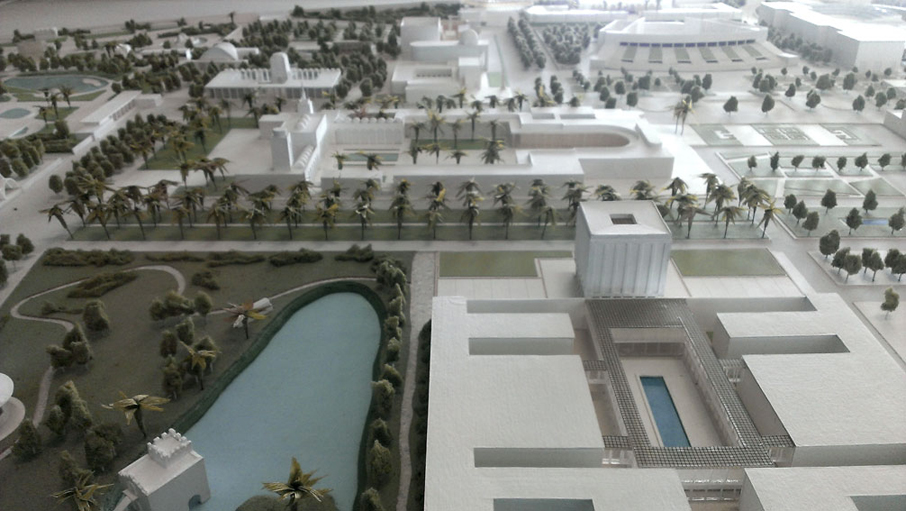



The Exhibition of Overseas (Mostra d'Oltremare) in Naples is one of the main Italian exhibition venues and, together with the Fiera del Levante in Bari, the largest in the south.

It covers an area of ??720 000 m² including buildings of considerable historical and architectural interest, as well as more modern exhibition pavilions, fountains (including the monumental Fountain of the Esedra), a tropical aquarium, gardens with a great variety of tree species and an archaeological park.

The Exhibition, born as the Triennale d'Oltremare, was conceived as a "Universal Thematic Exhibition", together with the park of the Universal Exhibition of Rome (later EUR), and set up in 1937, to host an event aimed at celebrating political expansion and economy of fascist Italy on the seas and in the so-called overseas lands.

For this purpose the city of Naples was chosen, which, by virtue of its central position in the Mediterranean, was considered the ideal starting point for the enterprising colonial policy of the fascist regime. The subject chosen for the first exhibition was a "Celebration of the glory of the Italian empire in North Africa and the Mediterranean".

The decision to locate the fair in the Neapolitan capital was followed by lively discussions in the city on the location of the initiative: among the proposed locations, the Conca Flegrea was finally opted - between Bagnoli and Fuorigrotta - which due to its flat configuration, proximity to the sea and to the archaeological areas of Cuma and Averno, according to the promoters it could perform the function of tourist and commercial pole better than any other place.

In this way, the project was historically placed within the wider program for the revitalization of the city that Mussolini had enunciated under the slogan "Naples must live" and had articulated in the famous 5 points listed to Neapolitan citizens in 1931: "Agriculture , Navigation, Industry, Handicraft, Tourism ".

Inevitably, the construction of the exhibition influenced the entire surrounding urban environment, which, if it suffered the demolition of the ancient agricultural farmhouse of Castellana, however, saw the construction of a real business and residential center, whose fulcrum became the modern Viale Augusto , road axis with two carriageways separated by a large central flowerbed with palm trees and pines, a road with a slightly and imperceptibly curved path, suitable for leading up to the square at the entrance to the Exhibition.

It took just sixteen months to build the whole structure.

Built on over 1,000,000 m², it consisted of: 36 exhibition halls; an office building; an outdoor arena with a capacity of more than 10,000 people; two theaters; an Olympic swimming pool; restaurants and cafes; an amusement park, a wildlife park and a tropical aquarium; a pre-existing archaeological area of ??the Roman period, included within the perimeter.

The exhibition re-proposed in its architectural structure the characteristics of the overseas colonies - in a context of evident imperial propaganda of the regime - and was conceived according to the models of green architecture; in fact the complex was configured from the beginning as a picturesque environment and today it can be considered as a significant episode of coexistence of the various artistic doctrines of the time.

This colossal ornamental plant, arranged to integrate the architecture, immediately presented innovative and contradictory aspects, as it was the vast repertoire of a provisional nature that represented a significant avant-garde role, compared to real works of art, assuming a function primary homologation with the spaces of the entire complex.

Officially inaugurated on May 9, 1940, by the Hon. Vincenzo Tecchio, then president of the Exhibition and in the presence of King Vittorio Emanuele III, the "I Triennial Exhibition of the Italian Overseas Lands" ended just a month later, due to the start of World War II and the subsequent bombings that hit it. with 60% of the buildings suffering extensive damage.

This unexpected event determined the total closure of the area, which was left in a total state of abandonment at the end of the conflict, due to economic but also ideological reasons.

In 1948 the "Triennial Exhibition of the Italian Overseas Lands" was transformed into "the Overseas Exhibition and Italian Labor in the World body", starting the reconstruction for the reopening.

This took place on June 8, 1952, when the doors of the "I Triennial Exhibition of Italian Labor in the World" opened wide; the extensive damage caused by the war had meanwhile been repaired: the buildings, destroyed or semi-destroyed, had been restored or rebuilt, the pre-existing ornamental cycle had been suitably restored and enriched, as well as the immense tree park.

The new function of the fair organization was initially identified in that of organizing documentary exhibitions on Italian activities and work in the world, as well as in pursuing purposes suitable for the promotion and economic and tourist enhancement of the city.

The economic failure of the event caused a worsening of the already very precarious financial situation, which was irreparably compromised and caused the cancellation of all the projects undertaken.

The exhibition was closed again, if not for some spaces and some periods; this gave rise, especially starting from the sixties, to a long and inexorable process of dispossession and decay, characterized by the partial and improper use of many structures, by the neglect of the green areas and, in particular, by the damage caused by occupation of the land on which the displaced people of the 1980 earthquake were arbitrarily settled, with no respect for the work, under the banner of a widespread condition of degradation, which reached its peak at the beginning of the nineties.

The exhibition is located in the Neapolitan district of Fuorigrotta: the area is connected to the rest of the city through the integrated transport system, thanks to the Cumana, line 6 (Mostra) and line 2 of the underground stops, the latter housed in the inside the Campi Flegrei railway station.

Exhibition of Overseas - Virtual Tour 360°
Address: Viale Kennedy, 54, 80125
Phone: 081 7258000
Site:
https://www.mostradoltremare.it/Location inserted by
CHO.earth